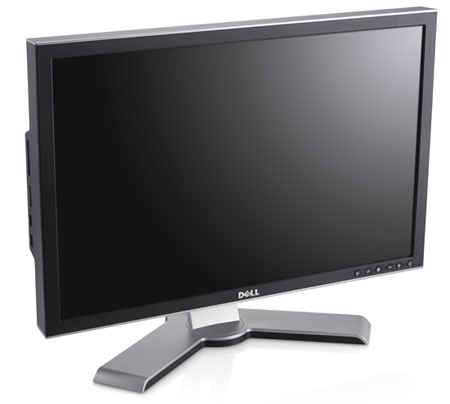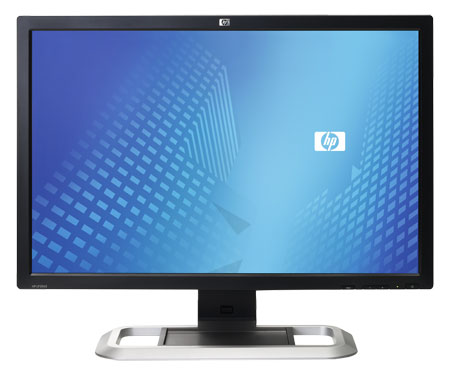$400-$800 High-End LCDs

As we move into the high-end LCDs, generally speaking we are looking at 24" and larger displays. One offering that you might want to jump on his the Dell 2408WFP, currently on sale for just $482 (though we're not sure how long that sale will last). We gave this monitor or Silver Editors' Choice award, as it has great features and also delivered some of the best color accuracy results we've seen to date. Particularly noteworthy is the fact that it scored 1.74 average Delta E without any calibration -- that's better than some LCDs do with calibration. The only drawback to the 2408WFP is a significant amount of input lag, although we understand that later revisions have reduced the lag to the point where it might be acceptable. We haven't been able to personally test the later revisions, so we don't know for sure how much the situation has improved, but if your primary concern is color quality this is still an excellent LCD.
Other options in this category are interesting, in that you can actually find a few S-IPS or S-MVA. For an S-IPS display, the HP LP2475w runs $585, which is more expensive than a lot of the competition, but our personal preference is still IPS over any of the other technologies. S-MVA panels are few and far between for whatever reason, and at present we are only aware of one LCD in the US that uses an S-MVA panel, the BenQ FP241VW... and it no longer appears to be in production. Still, prices have dropped significantly since the LCD launched, and our own testing indicates that input lag matches the best any of the other LCDs we've tested can offer. That means you can get wide viewing angles, good color accuracy, and still not have to sacrifice gaming potential. Finally, there are a few higher quality 22" LCDs that also fall into this category, like the Lenovo L220X, a 22" 1920x1200 LCD with an S-PVA panel. At $485 it costs as much as the Dell 2408WFP, but that's the price of a high resolution non-TN 22" LCD it seems. Finally, the Planar PX2611W is a 26" S-IPS panel that is very highly regarded by many owners, although it is priced quite a bit higher than the 24" LCDs, coming in at $765.
$900+ Dream LCDs

Last we have the ultra high-end LCDs, with prices that are more than most people will spend for an entire system. Generally speaking, if you're going to spend this much money we would recommend picking up a 30" LCD, but there are also imaging professionals that will want best in class performance. Most of the 30" LCDs use S-IPS panels and have similar performance characteristics, so it comes down to features. The Dell 3007WFP-HC and HP LP3065 go head-to-head at around $1200 -- the HP costs $50 more at present. The primary difference is that Dell has a single dual-link DVI input along with flash media slots, while HP skips on the flash reader but includes three dual-link DVI inputs. If you never intend on connecting your LCD to more than one computer, either LCD will work fine; if you might want to use a KVM switch down the road, however, know in advance that dual-link KVM switches are extremely expensive. We would give the edge to the HP LP3065, but the margin of victory is extremely small.
If you're looking for other 30" options, a slightly cheaper alternative that's worth a look is the DoubleSight DS-305W, which again uses an S-IPS panel but carries a $950 price tag. We haven't personally tested the display (yet), but $200 is nothing to scoff at compared to the HP LP3065. If you might prefer something other than an S-IPS panel, Samsung offers the 305T with an S-PVA panel for just over $1100. Input lag is reputed to be better than the 24" and 27" S-PVA panels, but we're not sure it's at the level of the 30" S-IPS panels. Finally, we should note that the newer Dell 3008WFP includes a bevy of input options, but apparently also suffers from severe input lag, making the $2000 price tag much more than we are willing to pay.
The final two options in the dream LCD category target imaging professionals, and both come from NEC. The 26" LCD2690WUXi uses an H-IPS panel and is priced at $1050, but among users that demand accurate color it has a very good reputation. The other option is another 30" S-IPS panel, the LCD3090WQXi that retails for $2000. If your livelihood depends on accurate colors in print media, the price premium over competing 30" options may not matter. Most users looking to pick up a 30" LCD will probably be more than happy with one of the cheaper options, however.










50 Comments
View All Comments
DBissett - Thursday, December 18, 2008 - link
Informative article, but the second paragraph under "$400-$800 High End Monitors" really needs some editing. The first sentence says we can find an S-MVA monitor. Then it says there is one available in the US but it's out of production. Then the monitor is discussed further, but the name of this product is never given. If it's available then name it, and if not then why discuss it at all? Too bad you couldn't get more to test. I too would be interested in the Eizo, although I've never seen one. I don't know where to see them in Houston.gorobei - Thursday, December 18, 2008 - link
they are probably referring to the hp lp2275. look it up on tft central. $360 at newegg right now.JarredWalton - Thursday, December 18, 2008 - link
Sorry... not sure how that slipped through the cracks, but the table on the table should have made is clear that I was discussing the BenQ FP241VW. Original MSRP was ~$900 I think, but I've seen it a few places for $600 now.OCedHrt - Thursday, December 18, 2008 - link
How does the Apple displays compare here (ie. what panel do they use)? I ask because my housemate is convinced that the demo photos look significantly more vibrant on Apple displays than on displays hooked up to a PC (he can't get the Apple display port display to hook up to a pc). Personally I feel it has to do with the different gamma settings that the photos are saved under as Apple displays are otherwise using the same sources for the panels.Rippar - Thursday, December 18, 2008 - link
Apple displays use Active Matrix LCD's, though I think there's more than that to separate them from other AMLCD's. They have great (read: jaw-droppingly awesome) color accuracy, but at the expense of bad input lag (on the order of 60-80 ms, I'd say).JarredWalton - Friday, December 19, 2008 - link
Ummm... everything is pretty much active matrix these days. Passive matrix LCDs are mostly used in cheap LCDs like digital watches. You can read about it on Wikipedia; I think there were some laptops with passive matrix tech about 8+ years ago, but I don't think any desktop LCDs were ever passive matrix.Rosaline - Thursday, December 18, 2008 - link
Regarding the Dell 3008WFP, you state that it has very high input lag, presumably because of the digital scaler. This seems like a real shame, since the digital scaler I felt was one of the main appeals of this monitor.Interestingly, it is currently actually slighter cheaper than the 3007WFP-HC for UK buyers.
Does this lag still apply when fed with a native resolution signal? Do you think that this lag is avoidable whilst still offering the advantages of the scaler?
JarredWalton - Thursday, December 18, 2008 - link
I never could get one for testing, so I'm speaking anecdotally. Most reviews I've seen show the lag as being roughly equal to the 2408WFP/2407WFP/2707WFP, which all have in the range of ~40ms lag. Since I never have found any other IPS 30" LCDs with that problem, I have to figure it's the scaler. And I agree, it's a shame. If you don't need to use the display as anything more than a computer LCD, just stick with the 3007WFP-HC or the LP3065 (or one of the other S-IPS with no scaler).superkdogg - Thursday, December 18, 2008 - link
I picked up the 22" Acer that you guys recommend a few weeks ago and couldn't be more pleased. Recognizing that you're not going to get the very top of the line for the lowest price, the monitor does everything I want from it, and the 16x10 resolution actually saves me more money because I don't have the itch to upgrade my graphics card constantly to take advantage of the the display.The drawbacks that I'd note on the Acer are that it does bleed light when sitting on an all-black screen like a blank desktop for example, and your comment about flimsy stand is dead on-if your desk isn't sturdy the stand may be flimsy enough to make you turn to a different monitor. If your desk is solid no problem at all, but if not it's an actual risk that your screen could tip over.
Mine also had a stuck blue pixel, but only one so whatever.
All-in-all, my desk is sturdy and I'm seldom sitting at my blank desktop where I can see the blue pixel and the light bleed so for practical purposes the monitor is awesome. I love it and consider it a great choice in the value segment.
Goty - Thursday, December 18, 2008 - link
It would be interesting to see what the matte finish on the 2401 does to the perceived color saturation vs the 2400. I bought an FHD2400 shortly after the release of the article here and couldn't be more pleased with it.